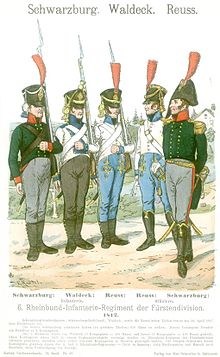Battle of La Bisbal
| Battle of La Bisbal | |||||||
|---|---|---|---|---|---|---|---|
| Part of Peninsular War | |||||||
 Bisbal Emporda castell | |||||||
| |||||||
| Belligerents | |||||||
|
|
| ||||||
| Commanders and leaders | |||||||
|
| Charles William Doyle | ||||||
| Units involved | |||||||
|
|
| ||||||
| Strength | |||||||
| 2,400[1] |
6,600[1] 2 British frigates[1] | ||||||
| Casualties and losses | |||||||
|
400 dead and wounded[1] 1,600 captured[1] 17 guns[1] | not mentioned[1] | ||||||
In the Battle of La Bisbal on 14 September 1810 a
The action occurred amid the events leading up to the
Background
In June 1810,
Located on the
MacDonald marched his field army of 16,000 troops south to support Suchet's operations against Tortosa. MacDonald left General of Division Louis Baraguey d'Hilliers with almost 10,000 soldiers to garrison Barcelona. In addition, there were 18,000 troops manning the defenses of other cities and holding open the road to France.[6]
Battle

Fane's Anglo-Spanish naval expedition struck first on 10 September. An amphibious force rowed ashore at
On the morning of the 14th, O'Donnell attacked La Bisbal in overwhelming force. As his pickets were driven in, Schwarz sent a courier with orders to his detachments to concentrate. Shortly afterward, La Bisbal was surrounded and its defenders fell back to an old castle. Unfortunately, the structure was dominated by a nearby hill and a church tower from which snipers picked off a few Germans during the day. Schwarz held out until evening; he surrendered after the Spanish began massing for an assault. The French commander did not put up much of a battle, losing only one officer and four men killed, and three officers and 16 rank and file wounded.[7]
While the action in La Bisbal was going on, Schwarz's other outposts were being snapped up. Fane and Doyle landed their troops at Palamós and captured it. Colonel Aldea's column overran Calonge while Colonel Fleires's column seized Sant Feliu. Rouyer at Girona was unable to intervene because O'Donnell called out the local miquelets to harass his garrison.[7] Schwarz, two colonels, 56 officers, 1,183 men, and 17 guns were captured for a total of 1,242 prisoners.[7] The Germans also lost approximately 400 killed and wounded. Spanish losses were not reported but were probably light.[9] However, they included O'Donnell who was badly wounded in the foot at La Bisbal. The Spanish general and the German prisoners were taken aboard Fane's squadron before it sailed back to Tarragona.[7]
Schwarz was held in captivity until the end of the war in 1814.
Aftermath
Campoverde took command of the land force and headed north past Girona before Rouyer or Baraguey d'Hilliers could react. He captured
Because he was so isolated from northern Catalonia by the guerillas, MacDonald did not hear of the La Bisbal disaster until three weeks later. Nevertheless, he initially maintained his position in support of Suchet.[17] By holding his ground MacDonald nullified O'Donnell's strategy. Other events would finally distract the marshal from his position in the south.[8]
When Campoverde moved south to Cardona, the marshal took two French and two Italian brigades to attack him. An Italian brigade attacked at once on 18 October and took a beating. MacDonald declined to press his enemies further because provisions in Barcelona were getting low. Instead he lumbered off to Girona so he could protect his supply convoys.
Notes
- ^ a b c d e f g h i Bodart 1908, p. 420.
- ^ Esdaile 2003, p. 334.
- ^ Gates 2002, p. 289.
- ^ a b Gates 2002, p. 292.
- ^ Smith 1998, pp. 342–343.
- ^ Oman 1902c, pp. 495–496.
- ^ a b c d e f g h i Oman 1902c, pp. 497–499.
- ^ a b Gates 2002, p. 293.
- ^ a b c Smith 1998, p. 345.
- ^ Six 1934, p. 440.
- ^ 'Register of French POWs, Edinburgh and Greenock, 1811-1812', The National Archives of the UK (TNA), ADM 103/112, accessed via Findmypast.
- ^ 'French POWs Released on Parole 1800-1815', The National Archives of the UK (TNA), ADM 103/611, accessed via Findmypast.
- ^ "Lodge St John, No. 111". Hawick News and Border Chronicle. 22 March 1918. p. 3.
- ^ Archives of Lodge St John, No. 111, Hawick, Scotland.
- ^ Oman 1902c, p. 501.
- ^ Chisholm 1911, pp. 8–9.
- ^ a b Oman 1902c, pp. 499–501.
- ^ Smith 1998, p. 353.
References
- Bodart, Gaston (1908). Militär-historisches Kriegs-Lexikon (1618-1905). Retrieved 24 May 2021.
- Chisholm, Hugh, ed. (1911). . Encyclopædia Britannica. Vol. 20 (11th ed.). Cambridge University Press. pp. 8–9.
- Esdaile, Charles J. (2003). The Peninsular War. Palgrave MacMillan. ISBN 9781403962317. Retrieved 24 May 2021.
- Gates, David (2002). The Spanish Ulcer: A History of the Peninsular War. London: Pimlico. ISBN 0-7126-9730-6.
- Oman, Sir Charles William Chadwick (1902c). A History of the Peninsular War. Vol. III. Oxford: Clarendon Press. Retrieved 24 May 2021.
- Six, Georges (1934). "Schwarz (François-Xavier de)". Dictionnaire biographique des généraux et amiraux français de la Révolution et de l'Empire: 1792–1814 (in French). Vol. 2. Paris: Librairie Historique et Nobilaire. p. 440.
- Smith, Digby (1998). The Napoleonic Wars Data Book. London: Greenhill. ISBN 1-85367-276-9.


